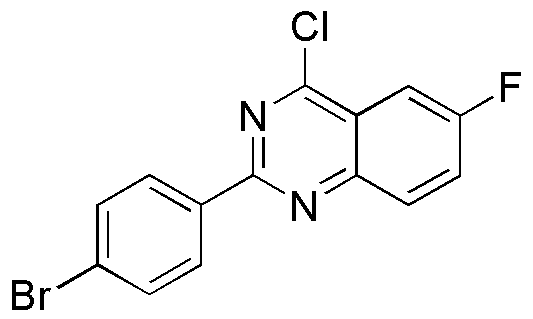2-(4-Bromophenyl)-4-chloro-6-fluoro-quinazoline is widely utilized in research focused on:
- Pharmaceutical Development: This compound serves as a key intermediate in the synthesis of various pharmaceuticals, particularly in the development of targeted cancer therapies due to its ability to inhibit specific kinases.
- Biological Research: It is used in studies investigating the mechanisms of action of certain enzymes and receptors, helping researchers understand disease pathways and potential treatment targets.
- Material Science: The compound can be incorporated into novel materials, enhancing their properties for applications in electronics and photonics, where improved performance and stability are crucial.
- Agricultural Chemistry: It has potential applications in developing agrochemicals, particularly as a pesticide or herbicide, providing effective solutions for crop protection.
- Diagnostic Tools: This chemical can be utilized in the formulation of diagnostic agents, aiding in the detection of specific biological markers in medical diagnostics.
General Information
Properties
Safety and Regulations
Applications
2-(4-Bromophenyl)-4-chloro-6-fluoro-quinazoline is widely utilized in research focused on:
- Pharmaceutical Development: This compound serves as a key intermediate in the synthesis of various pharmaceuticals, particularly in the development of targeted cancer therapies due to its ability to inhibit specific kinases.
- Biological Research: It is used in studies investigating the mechanisms of action of certain enzymes and receptors, helping researchers understand disease pathways and potential treatment targets.
- Material Science: The compound can be incorporated into novel materials, enhancing their properties for applications in electronics and photonics, where improved performance and stability are crucial.
- Agricultural Chemistry: It has potential applications in developing agrochemicals, particularly as a pesticide or herbicide, providing effective solutions for crop protection.
- Diagnostic Tools: This chemical can be utilized in the formulation of diagnostic agents, aiding in the detection of specific biological markers in medical diagnostics.
Documents
Safety Data Sheets (SDS)
The SDS provides comprehensive safety information on handling, storage, and disposal of the product.
Product Specification (PS)
The PS provides a comprehensive breakdown of the product’s properties, including chemical composition, physical state, purity, and storage requirements. It also details acceptable quality ranges and the product's intended applications.
Certificates of Analysis (COA)
Search for Certificates of Analysis (COA) by entering the products Lot Number. Lot and Batch Numbers can be found on a product’s label following the words ‘Lot’ or ‘Batch’.
*Catalog Number
*Lot Number
Certificates Of Origin (COO)
This COO confirms the country where the product was manufactured, and also details the materials and components used in it and whether it is derived from natural, synthetic, or other specific sources. This certificate may be required for customs, trade, and regulatory compliance.
*Catalog Number
*Lot Number
Safety Data Sheets (SDS)
The SDS provides comprehensive safety information on handling, storage, and disposal of the product.
DownloadProduct Specification (PS)
The PS provides a comprehensive breakdown of the product’s properties, including chemical composition, physical state, purity, and storage requirements. It also details acceptable quality ranges and the product's intended applications.
DownloadCertificates of Analysis (COA)
Search for Certificates of Analysis (COA) by entering the products Lot Number. Lot and Batch Numbers can be found on a product’s label following the words ‘Lot’ or ‘Batch’.
*Catalog Number
*Lot Number
Certificates Of Origin (COO)
This COO confirms the country where the product was manufactured, and also details the materials and components used in it and whether it is derived from natural, synthetic, or other specific sources. This certificate may be required for customs, trade, and regulatory compliance.


